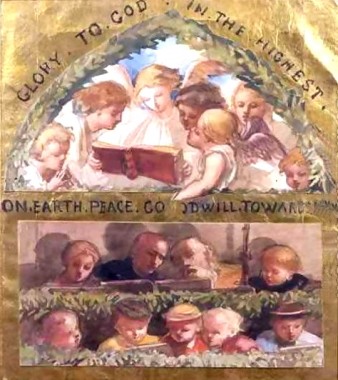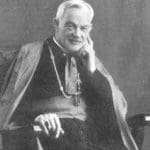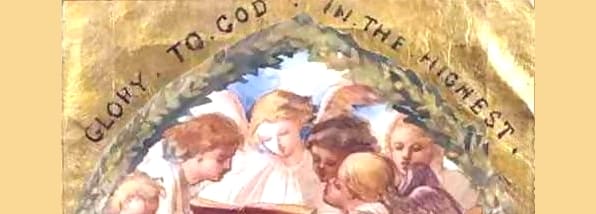THE ANGELS’ SONG
“And suddenly there was with the Angel a multitude of the Heavenly host, praising God and saying, Glory to God in the highest, and on earth peace to men of goodwill.”
Luke 2:13-14
1. It was fitting that this manifestation of the angels should have been made on this night of the Nativity. The fathers of the Church, when speaking of the fall of the rebel angels, tend to explain it as the refusal to adore the Incarnate God that was to be; they would not bow down before Him who was to make Himself “less than the angels.” Hence, when the actual manifestation came, those who had been faithful could not but have rejoiced; they must have seen in that Child more than even Mary saw, for they saw His Godhead shining through His human frame, and they recognized in Him the great union of God with men. Later our Lord was to speak of His own love for and reliance on His angels; in the entrusting to them of children, in the use He would make of them to separate the just from the unjust, in the acceptance of an angel to strengthen Him in the Garden of Gethsemane; in the knowledge that He had but to ask His Father and legions of angels would come to His support. Christmas Day, then, is a feast of the angels as well as of men.
 2. “Glory to God in the highest, and on earth peace to men of goodwill.” This was the angels’ song of praise. It has two divisions. First, at the moment of our Lord’s great humiliation on this earth, the angels break out with their chorus of praise. St. Paul saw it in the same light: “He hath humbled Himself . . . therefore God hath exalted Him.” Then the consequences to war-worn man are recorded. Man at war with God, man at war with himself, man all restless, is at last to be given peace, if only he will have it. Again St. Paul sees with the angels’ eyes: “He is our peace,” he says, “Who hath made both one, and breaking down the middle wall of partition, the enmities, in His flesh, making void the law of commandments contained in decrees, that He mighty make the two in Himself into one man, making peace, and might reconcile both to God in one body on the cross, killing the enmities in Himself.” It was not merely the “Pax Romana,” at that moment reigning, that the angels announced; it was the still “greater Peace which the world cannot give,” which those know who possess it.
2. “Glory to God in the highest, and on earth peace to men of goodwill.” This was the angels’ song of praise. It has two divisions. First, at the moment of our Lord’s great humiliation on this earth, the angels break out with their chorus of praise. St. Paul saw it in the same light: “He hath humbled Himself . . . therefore God hath exalted Him.” Then the consequences to war-worn man are recorded. Man at war with God, man at war with himself, man all restless, is at last to be given peace, if only he will have it. Again St. Paul sees with the angels’ eyes: “He is our peace,” he says, “Who hath made both one, and breaking down the middle wall of partition, the enmities, in His flesh, making void the law of commandments contained in decrees, that He mighty make the two in Himself into one man, making peace, and might reconcile both to God in one body on the cross, killing the enmities in Himself.” It was not merely the “Pax Romana,” at that moment reigning, that the angels announced; it was the still “greater Peace which the world cannot give,” which those know who possess it.
3. The Church has taken these words of the angels and has built upon them one of the most beautiful of her hymns. In the first part she dwells on and expands the first words of the angels, endeavouring to give expression to their affections when she sings: Laudamus te, benedicimus te, adoramus te, glorificamus te. Gratias agimus tibi propter magnam gloriam tuam [We praise you, we bless you, we adore you, we glorify you, we give you thanks for your great glory]. Then the hymn turns to the earthly results of the great mystery, hailing our Lord as the Incarnate Son, the Lamb of God, who brings about peace on earth by means of the redemption in His blood. This is God and Man, the Redeemer, Who taketh away the sins of the world. And, lastly, He is called upon as having accomplished His work and reigning in heaven, where He is associated with the Father and the Holy Ghost: Domine Fili unigenite, Jesu Christe. Domine Deus, Agnus Dei, Filius Patris. Qui tollis peccata mundi, miserere nobis. Qui tollis peccata mundi, suscipe deprecationem nostram. Quoniam tu solus sanctus, tu solus Dominus, tu solus altissimus, Jesu Christe, cum Sancto Spiritu in gloria Dei Patris [Lord Jesus Christ, Only Begotten Son, Lord God, Lamb of God, Son of the Father, you take away the sins of the world, have mercy on us; you take away the sins of the world, receive our prayer…For you alone are the Holy One, you alone are the Lord, you alone are the Most High, Jesus Christ, with the Holy Spirit, in the glory of God the Father].
Summary Meditation Points:
1. The fitness of the adoration of the Angels at the Nativity.
2. The fitness of their song: Glory to God, peace to men of goodwill.
3. The development of this by the Church.
 Editor’s Note: This meditation is from Archbishop Alban Goodier’s “The Prince of Peace” (1913).
Editor’s Note: This meditation is from Archbishop Alban Goodier’s “The Prince of Peace” (1913).
Art: Glory to God in the Highest, Louisa Anne, Marchioness of Waterford, 1800s, PD copyright expired, Wikimedia Commons. Archbishop Alban Goodier, S.J., www.stmaryscadoganstreet.co.uk, all rights reserved, used with permission.




